Haier WS50GDBI Review
Haier WS50GDBI Review
This wine cellar is a sumptuous slice of kitchen luxury
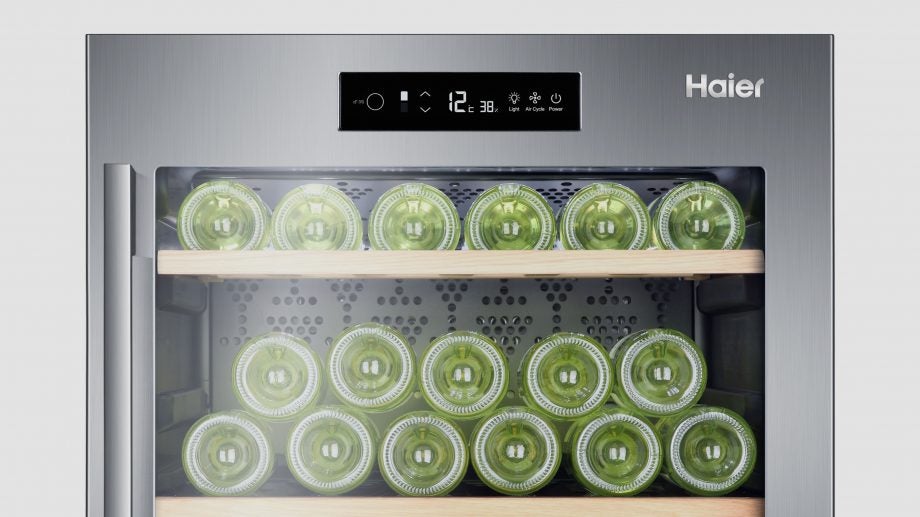
Verdict
Pros
- Excellent temperature stability
- Anti-vibration motor
- Filtered air circulation
- Sumptuous design
Cons
- Eye-watering price
- Wooden shelves don’t slide out
Key Specifications
- Review Price: £999.99
- 50-bottle capacity; two independent zones; B energy efficient; stainless steel finish; glass door; air conditioning; anti-vibration compressor; wine cellar
What is the HAIER WS50GDBI?
Brand new to the market is the smallest of Haier’s premium range of dedicated wine cellars. The WS50GDBI offers a 50-bottle capacity split equally between two independent temperature-controlled zones and packs in features for the dedicated wine connoisseur. These include highly stable temperature, humidity-controlled air conditioning and active cabinet heating (or ‘low-temperature compensation’) should the ambient room temperature fall below your ideal drinking temperature.
Haier’s super-quiet anti-vibration motor ensures the wine isn’t shaken or stirred, and the zones can be set from 5 degrees to 20 degrees, making this suitable for both red and white wines. The forced-air-circulation cooling includes an activated charcoal filter, which removes any odours that could potentially taint the wine as it matures. Haier recommends replacing the filter annually to keep this feature running at its best. Energy class B is not unusual in wine chillers, as the additional electricity required to keep the humidity controlled and temperature stable all adds up.
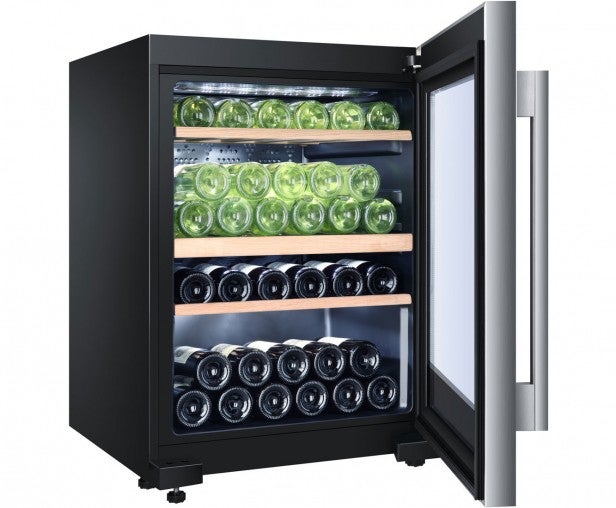
HAIER WS50GDBI: How does it look?
The WS50GDBI leaves you in no doubt this is a classy premium product. The brushed stainless steel door frame is lush, yet picks up finger marks easily. Moreover the steel doesn’t extend to the sides or top of the cabinet, which are hard-wearing black paint. If this wine chiller is going under a worktop and between cabinets that won’t be an issue, of course, but freestanding at the end of our kitchen we would have liked a full stainless steel wrap at this price.
The door has a nicely tinted glass front, so you can see the bottles and wooden shelves within. The light can be set to come on with the door open and stay on a few seconds after closing, or left on permanently to make your wine collection a room feature. As it uses LED lighting throughout, this doesn’t have a great impact on running costs, either.
The door-mounted LED display features touchscreen controls and indications of temperature (either top or bottom zone displayed at any one time) and humidity percentage of the air inside the cabinet. This display also offers controls for the light and the air-cycle fan that speeds up temperature stabilisation and de-mists the door after it’s been opened. There’s a lock on the bottom of the door should you wish to keep guests or other family members away from your vintage Moët.
For those used to glass shelves of a traditional fridge, the raw wooden racks may look rather unusual. Yet not only do they add to the visual appeal but the wood is also gentle on bottle labels, resists bacteria naturally and has some properties to remove odours from the cabinet. If you do spill wine on them, a quick buff with some fine-grade sandpaper will bring them up like new.
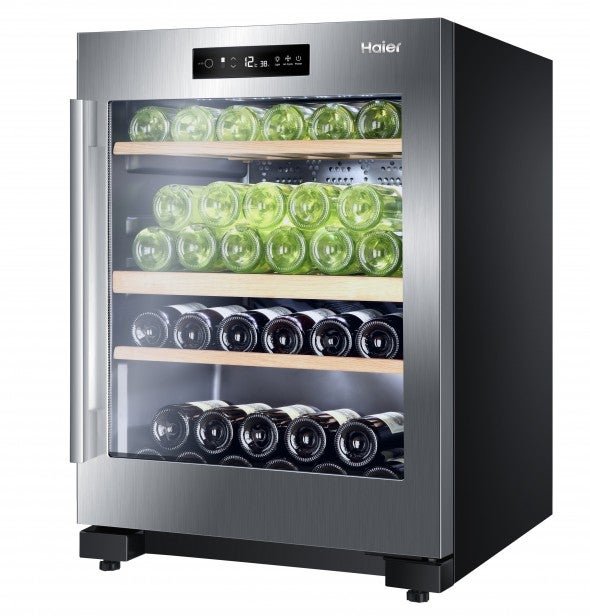
HAIER WS50GDBI: How much can you fit in?
Haier’s quoted 50-bottle maximum capacity is rather ambitious. We managed 46, although the size of the bottles will come into play. Moreover, getting this many bottles inside means cross-stacking bottles on top of each other, where one bottle is facing cork-out and the next row has to be cork-in, with the base facing the glass door, which is neither elegant nor very practical for accessing particular wines from your collection. We’d suggest that the maximum sensible capacity is around 35 bottles for ease of access.
While the central dividing shelf is fixed, the two supplied wooden shelves are removable, with the upper shelf offering two positions. In an ideal world we would have liked to have seen the lower removable shelf capable of sliding out on a runner so you can more easily read the wine labels, but with wine on board it’s fixed in place. Of course, with the independently controlled zones you’re not only restricted to wine and you can easily set one compartment to 5 degrees to store beers or soft drinks.
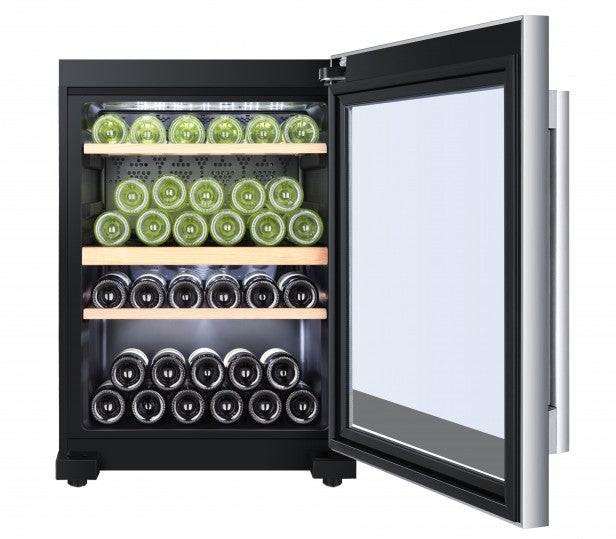
SEE ALSO: Best Toasters
HAIER WS50GDBI: How noisy is it?
Haier uses a standard compressor, but’s cleverly mounted this on anti-vibration turrets to both keep it quiet and stop the wine shaking arounf. Even when the compressor is running you can’t feel any vibration through the cabinet and it’s very quiet – around 41dB. This compares fairly well with Haier’s quoted 39dB, and if the unit was mounted under a counter-top it would have been even quieter than our free-space tests.
HAIER WS50GDBI: How well does it perform?
Looking up the best temperature to serve our favourite tipples, it transpires that Rioja is best served at around 16 degrees C and our collection of finest Sauvignon Blancs – Tesco’s Finest, that is – were best at around 9 degrees. After a few experimental glasses we decided we preferred our favourite wines a little cooler than recommended so set the lower compartment to 14 degrees C for the reds and the upper at 6 degrees C for the white wine and a few cheeky lagers.
Haier cycles the compressor on and off much quicker than a traditional refrigerator and, combined with the forced-air cooling, the result is incredibly stable average air temperature throughout the WS50GDBI cabinet. It’s an order of magnitude more stable that most refrigerators, with the bottom half of the lower section maintaining 13 degrees with a variation of just /- 0.2 degrees!
While there were peaks and dips of /-1 degree on the upper shelf in the lower compartment, they were so brief that ambient mean temperatures remained less than /- 0.3 degrees away from the 14 degrees we set. It was exactly the same story for the upper compartment, with the bottom shelf keeping at 5.5 degrees and the upper shelf around 6.5 degrees throughout the test. That is close to a technically perfect set of refrigerator results as we’re yet to see.
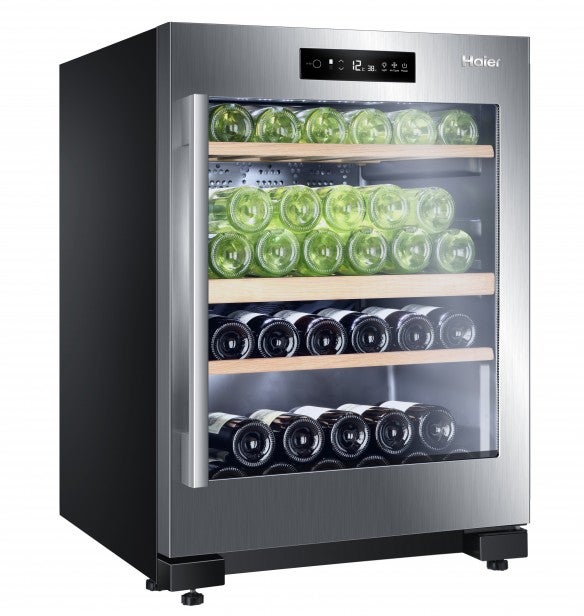
HAIER WS50GDBI: How much will it cost to run?
We didn’t give the Haier an easy test of its running costs. We set the thermostats at lower temperatures than most wine enthusiasts might require, made the upper zone the colder one – arguably it would have been more efficient the other way round – and opened the door frequently for those cheeky beers. So we were pleasantly surprised that we don’t think it’ll use even as much electricity as Haier’s own figures suggest. From our usage we calculate that it would use around 140kWh – equal to about £21 per year for perfectly chilled wine.
Should I buy the HAIER WS50GDBI?
Wine cellars are not for everyone and are, of course, very much a luxury item. Even the WS50GDBI’s price tag might make you wince, considering you can buy a very accomplished full-size fridge freezer for a whole lot less. However, if you’re in the market for a premium under-counter wine cellar that looks great, will store red and white wine simultaneously, is packed with features and turns in some very impressive technical results, the WS50GDBI is certainly a ‘premier cru’ of its type.
Next, read more Home Appliance Reviews


